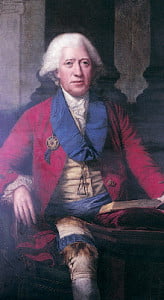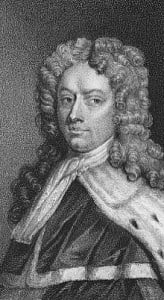For speculative Freemasons, times have always been a-changin’, and the erection of the Premier Grand Lodge by ‘Four Old Lodges’ in 1717 was itself a novelty. When, in 1722 the Grand Master, the Duke of Wharton, laid down the procedure for constituting a new Lodge, this was almost revolutionary.
Not only had it not occurred to anyone before this that a special ceremony was needed to do such a thing, but it was the first time since 1717 that the detailed ritual for any ceremony had been written down. When, during the next 30 years the Royal Arch emerged from the shadows, many brethren in the Premier Grand lodge considered this not only a novelty, but an outrage – it was not ‘Pure Ancient Masonry’.

Those who founded the Grand Lodge of the Antients in 1751 took the opposite view – they regarded the Royal Arch as “the heart and marrow of Masonry.” However, by the end of the century the Premier Grand Lodge – the Moderns – had not only recognised the Degree, but had set up a Grand and Royal Arch Chapter, something which the Antients never effectively did.
Often too little thought is given to how Masonic developments taking place in London affected Brethren and Companions in the rest of the country. The “collective wisdom of the tribe” to use Galbraith’s phrase, is that communications in England were so poor at the end of the 18th century that it is a wonder that changes made in London ever filtered down to distant communities. And where was more remote than the north coast of Cornwall, 300 miles from London, the other side of Exmoor, Dartmoor and Bodmin Moor.
Here, Freemasonry flourished in many towns, including Redruth, where for some 40 years before his death in 1828 John Knight was the leading Masonic figure.
In fact, Knight was to correspond at considerable length with leading London masons – Thomas Dunckerley, Robert Gill and Edward Harper for example – with little more difficulty than he would have experienced today.
Weekly at 2pm each Friday the mail coach left neighbouring Truro for London, where it arrived on Monday morning, and weekly it left London at mid-day on Tuesday and returned to Truro on Thursday. In 1791 Dunckerley, “the Grand Master of Royal Arch Masons”, could reply from Hampton Court on 15 July to a letter written in Cornwall three days earlier.
Parcel post took no longer, for packages of regalia, Books of Constitutions and Lodge and Chapter furnishings travelled on the same mail coach. Cornish Freemasons could be made aware of developments in London as they occurred, little more slowly than would be the case today.
The letter which Dunckerley wrote on 15 July 1791 provided a Dispensation to open the Druids Chapter of Love and Reality in Redruth – at the time there was a tradition in Cornwall that the Ancient Druids had brought Freemasonry to the country
It was a Dispensation and not a Warrant or Charter “as the Grand Chapter will not meet til the last Thursday in Oct.” Dunckerley wrote it out in due form in his own hand on the back of the letter. John Knight was named as the First Principal Z., an office which he was to occupy for the rest of his life.
Consecrations differed somewhat from what we are used to today. A senior Companion would be delegated to install the three principals, who appointed their officers at the following meeting.
For example, in 1810 John Foulstone, the Grand Recorder, was delegated to travel to Falmouth to install the principals of the newly Warranted Valubian Chapter. He took the Chair of ZX, with John Knight acting as H. Foulstone “opened [a Chapter] in Ample form the several Comps who had not passed the Chair of Zerubi being duly passed with the proper Signs & Words.”
In other words, all those present were made Passed Zs so that they could witness the installations. [To have been Exalted, a Brother would already either have presided over a Lodge as it Master, or have been through a ‘Passing the Chair’ ceremony.]
When the Druids Chapter of Love and Liberality had been founded in 1791, Knight had evidently wanted the Companions to be properly clothed. He wrote to Dunckerley in August 1792 wishing to obtain “proper Royal Arch Masons Aprons”, but received the reply that “Royal Arch aprons were directed to be worn by the old Chapters, but to have been discarded for several years, & Sashes being deem’d sufficient.”
Dunckerley omitted to point out that the reason why sashes had been “deem’d sufficient” was because Grand lodge had refused to allow Companions to wear their red-bordered aprons in Craft Lodges, with the result that in a fit of pique Grand Chapter ordered them to be discarded.
In the early 19th century new regalia was designed for Royal Arch Companions, so that John Knight could write to London in 1803: “You mentd. in your last letter that patterns of Jewells & aprons to be worn by officers and companions of the order were to be fixed on & when ready shall be glad to know what they are.” The new aprons had the indented red and blue border with which we are familiar today. But these were minor changes compared with those imposed by Supreme Grand Chapter when it was formed in 1817, four years after the Union of the Grand lodges.

For example, while each Antient Chapter worked under the Warrant of the lodge from which it had sprung, a Modern Chapter such as Love and Liberality had been granted its own separately numbered Warrant. Now, every Royal Arch Chapter had to be sponsored by a regularly Warranted lodge, the number of which it assumed.
Supreme Grand Chapter then issued Charters of Confirmation” to each Chapter which complied with this instruction, those formerly Modern and Antient alike. For some reason this gave John Knight particular concern. He involved himself in considerable correspondence to ensure that the new Charter would fit exactly into the frame which surrounded the former Warrant.
John Knight then summoned the Companions of his Chapter to an especial meeting “for the purpose of framing Bye- Laws, entering into Annual Subscription, Electing members for the Better Regulating & Support of the Royal Arch Chapter.”
Up to this time there had been no well defined ‘Membership’ of a Chapter. Now, in accordance with the new Regulations of the order, all those who had previously been Exalted in the Chapter had to make the decision whether they should formally become members of it.
This would involve them in paying an annual subscription and adhering to its bye-laws – which had yet to be written – or being excluded from it except as visitors. Several Companions who had formerly considered themselves part of the Chapter declined to become subscribing members. However, John Knight was elected to continue as First Principal. The records of how John Knight and his Companions reacted to the further changes which were made in his lifetime have not survived, and Love and Liberality Chapter itself did not long survive his death in 1828. His 35-year reign may have made it impossible to find anyone to follow him. Redruth was then without Royal Arch Masonry for nearly 40 years.
John Mandleberg is Master of Quatuor Coronati Lodge No. 2076, the premier Lodge of Masonic research
Sources
Royal Arch Masons and Knights Templar at Redruth, Cornwall, 1791–1828, C J Mandleberg and L.W. Davies, QCCC Ltd.
